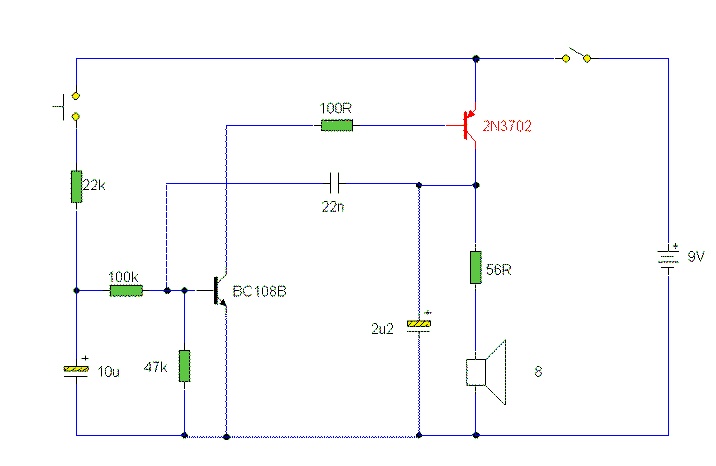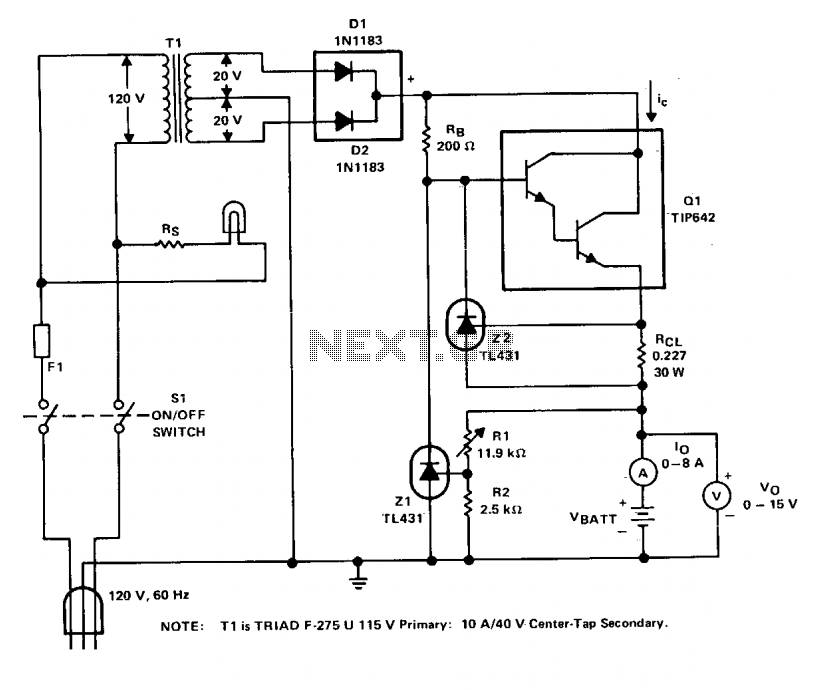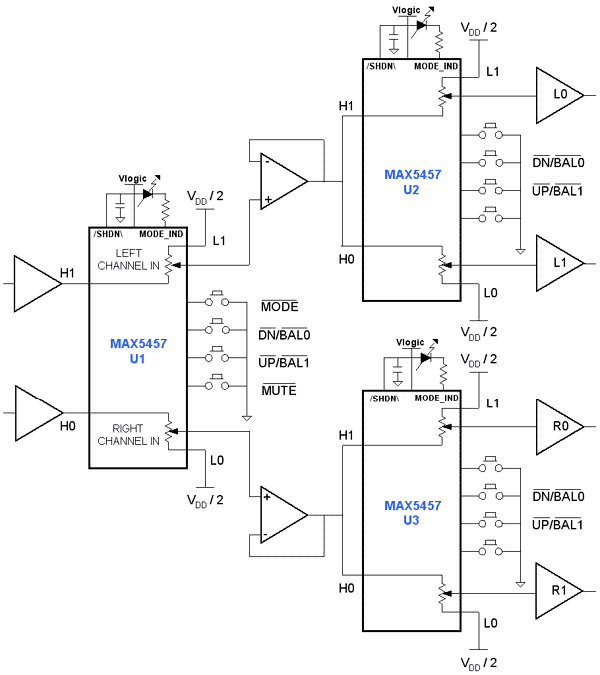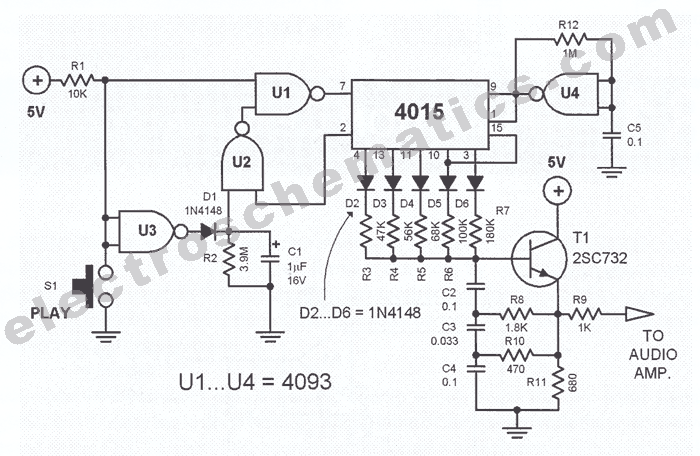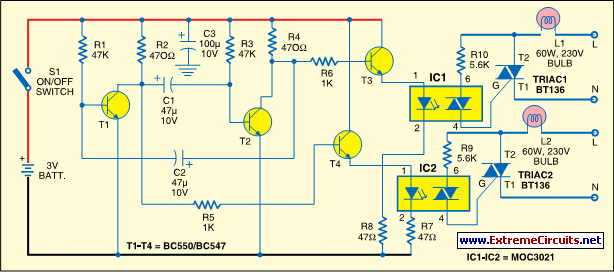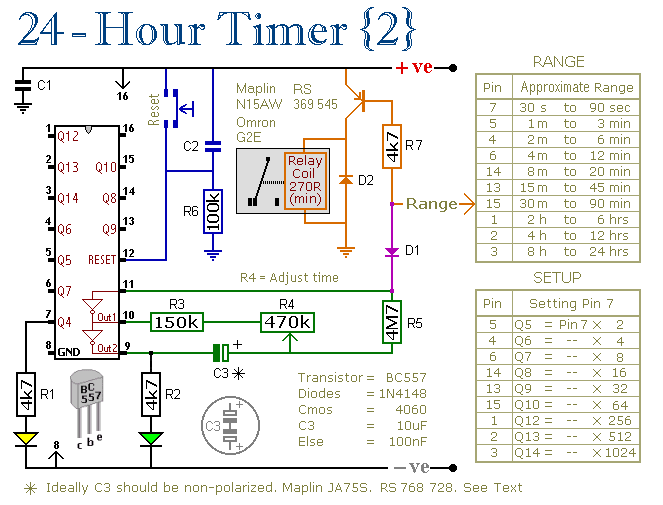
555 DC power supply circuit diagram of a protection device
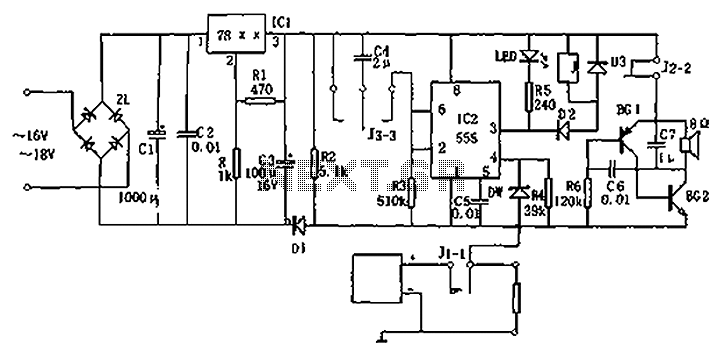
Circuit diagram for a DC power supply protection circuit. The device includes a buck rectifier power supply, a monostable delay circuit, a relay control circuit, and an audio feedback oscillation circuit. The entire circuit operates with a DC voltage Vdd, which can range from +5V to +12V, depending on the specific value of the VDD regulator block IC1. The monostable delay circuit is composed of IC2 (555 timer) along with resistors R3 and capacitor C4, among other components. Typically, the normally closed contact J1-1 is closed, allowing the potential at pin IC2 to remain high (above 1V). In the event of a load short-circuit, the potential at pin 555 drops to low (0.6V), causing the output pin to reset low, which disengages the relay contacts J1-1 and disconnects the short-circuited load. Meanwhile, contacts J2-2 and J3-3 are connected, enabling the audio feedback oscillator (BG1, BG2, C6, C7, R6) to produce an oscillating voltage, generating an approximate 1 kHz acoustic signal to alert the user. After contact J3-3 is switched, capacitor C4 charges through resistor R3, causing a drop in the potential at the 555 timer's pin. When this potential falls below 1/3 of VDD, the 555 timer sets, allowing the output pin J to enable the relay, reconnecting contact J1-1. If the short-circuit condition persists, the circuit remains protected. The charging time of C4 determines the delay time (td) for the protection, calculated as 1.1R3C4. This protection circuit can safeguard a DC voltage source and is suitable for integration into various power supply designs, with an output voltage range of 1.5V to 50V DC. In the event of a short circuit, the system can disconnect the load within 0.1 seconds for protection, and the delay circuit also features an auto-recovery function.
The DC power supply protection circuit is designed to ensure safe operation of power supply systems by integrating several key components that work together to manage short-circuit conditions effectively. The buck rectifier power supply converts higher DC voltages to a stable lower voltage, which is essential for the operation of subsequent circuitry. The monostable delay circuit, utilizing the 555 timer, plays a critical role in monitoring the load conditions and providing a timed response to potential faults.
When the circuit experiences a short-circuit condition, the immediate response is to disengage the load to prevent damage to the power supply. The relay control circuit, activated by the 555 timer's output, ensures that the load is disconnected swiftly, minimizing the risk of overheating or failure. The audio feedback circuit serves as an additional layer of user notification, producing an audible signal that alerts operators to the fault condition, thereby prompting timely intervention.
The component values, particularly those of R3 and C4, are crucial as they define the delay time for the system's recovery from a fault condition. By adjusting these values, the protection circuit can be tailored to specific applications, allowing for flexibility in various power supply designs. The auto-recovery feature enhances the usability of the circuit, as it automatically reconnects the load once the fault condition is resolved, ensuring minimal downtime.
In summary, this DC power supply protection circuit is an essential component for safeguarding power systems, providing a reliable mechanism for fault detection, load disconnection, and user notification, all while allowing for customizable protection parameters. Circuit diagram for the DC power supply protection circuit. The device consists of buck rectifier power supply, monostable delay circuit, relay control circuit, audio feedback oscillation circuit. The entire circuit DC voltage Vdd, and Vdd where the buck rectifier power supply is + (5 ~ 12) V, depending on the value of specific VDD regulator block IC1 may be. Monostable delay circuit consists of IC2 (555) and R3, C4 and other components. Usually, normally closed contact J1-1 is closed, so that the potential of pin IC2 normal load is high (1V above), when the load is short-circuited due to 555 feet potential is low ( 0.6V) and is forced to reset output pin low J pull the relay contacts J1-1 off, cut off the short-circuit load.
Meanwhile contacts J2-2, J3-3 respectively connected, so that the audio feedback oscillator BG1, BG2, C6, C7, R6 and composition by applying a voltage oscillation, which issued about lkHz acoustic signal to alert the use to pay attention. After contact J3-3 switched, C4 is charged through R3 so IC potential drop foot, when the potential of pin falls below 1/3VDD, 555 occurs is set.
high output enable pin J release, contact J1-1 connected. If this time is still short-circuited, then protected. C4 of the respective charging time is 555 delay guard time td 1.1R3C4. Protection time can be adjusted by changing the time constant R3C4. The protection circuit may short-circuit protection DC voltage source, which can be used as an annex to the voltage source, or any power supply design, integrated design. Its l.5 ~ 50V DC output voltage in the range of source in the event of a short circuit at a speed of 0.1 seconds to switch the load, for protection, and this delay circuit also has auto-recovery function.
The DC power supply protection circuit is designed to ensure safe operation of power supply systems by integrating several key components that work together to manage short-circuit conditions effectively. The buck rectifier power supply converts higher DC voltages to a stable lower voltage, which is essential for the operation of subsequent circuitry. The monostable delay circuit, utilizing the 555 timer, plays a critical role in monitoring the load conditions and providing a timed response to potential faults.
When the circuit experiences a short-circuit condition, the immediate response is to disengage the load to prevent damage to the power supply. The relay control circuit, activated by the 555 timer's output, ensures that the load is disconnected swiftly, minimizing the risk of overheating or failure. The audio feedback circuit serves as an additional layer of user notification, producing an audible signal that alerts operators to the fault condition, thereby prompting timely intervention.
The component values, particularly those of R3 and C4, are crucial as they define the delay time for the system's recovery from a fault condition. By adjusting these values, the protection circuit can be tailored to specific applications, allowing for flexibility in various power supply designs. The auto-recovery feature enhances the usability of the circuit, as it automatically reconnects the load once the fault condition is resolved, ensuring minimal downtime.
In summary, this DC power supply protection circuit is an essential component for safeguarding power systems, providing a reliable mechanism for fault detection, load disconnection, and user notification, all while allowing for customizable protection parameters. Circuit diagram for the DC power supply protection circuit. The device consists of buck rectifier power supply, monostable delay circuit, relay control circuit, audio feedback oscillation circuit. The entire circuit DC voltage Vdd, and Vdd where the buck rectifier power supply is + (5 ~ 12) V, depending on the value of specific VDD regulator block IC1 may be. Monostable delay circuit consists of IC2 (555) and R3, C4 and other components. Usually, normally closed contact J1-1 is closed, so that the potential of pin IC2 normal load is high (1V above), when the load is short-circuited due to 555 feet potential is low ( 0.6V) and is forced to reset output pin low J pull the relay contacts J1-1 off, cut off the short-circuit load.
Meanwhile contacts J2-2, J3-3 respectively connected, so that the audio feedback oscillator BG1, BG2, C6, C7, R6 and composition by applying a voltage oscillation, which issued about lkHz acoustic signal to alert the use to pay attention. After contact J3-3 switched, C4 is charged through R3 so IC potential drop foot, when the potential of pin falls below 1/3VDD, 555 occurs is set.
high output enable pin J release, contact J1-1 connected. If this time is still short-circuited, then protected. C4 of the respective charging time is 555 delay guard time td 1.1R3C4. Protection time can be adjusted by changing the time constant R3C4. The protection circuit may short-circuit protection DC voltage source, which can be used as an annex to the voltage source, or any power supply design, integrated design. Its l.5 ~ 50V DC output voltage in the range of source in the event of a short circuit at a speed of 0.1 seconds to switch the load, for protection, and this delay circuit also has auto-recovery function.
Warning: include(partials/cookie-banner.php): Failed to open stream: Permission denied in /var/www/html/nextgr/view-circuit.php on line 713
Warning: include(): Failed opening 'partials/cookie-banner.php' for inclusion (include_path='.:/usr/share/php') in /var/www/html/nextgr/view-circuit.php on line 713
